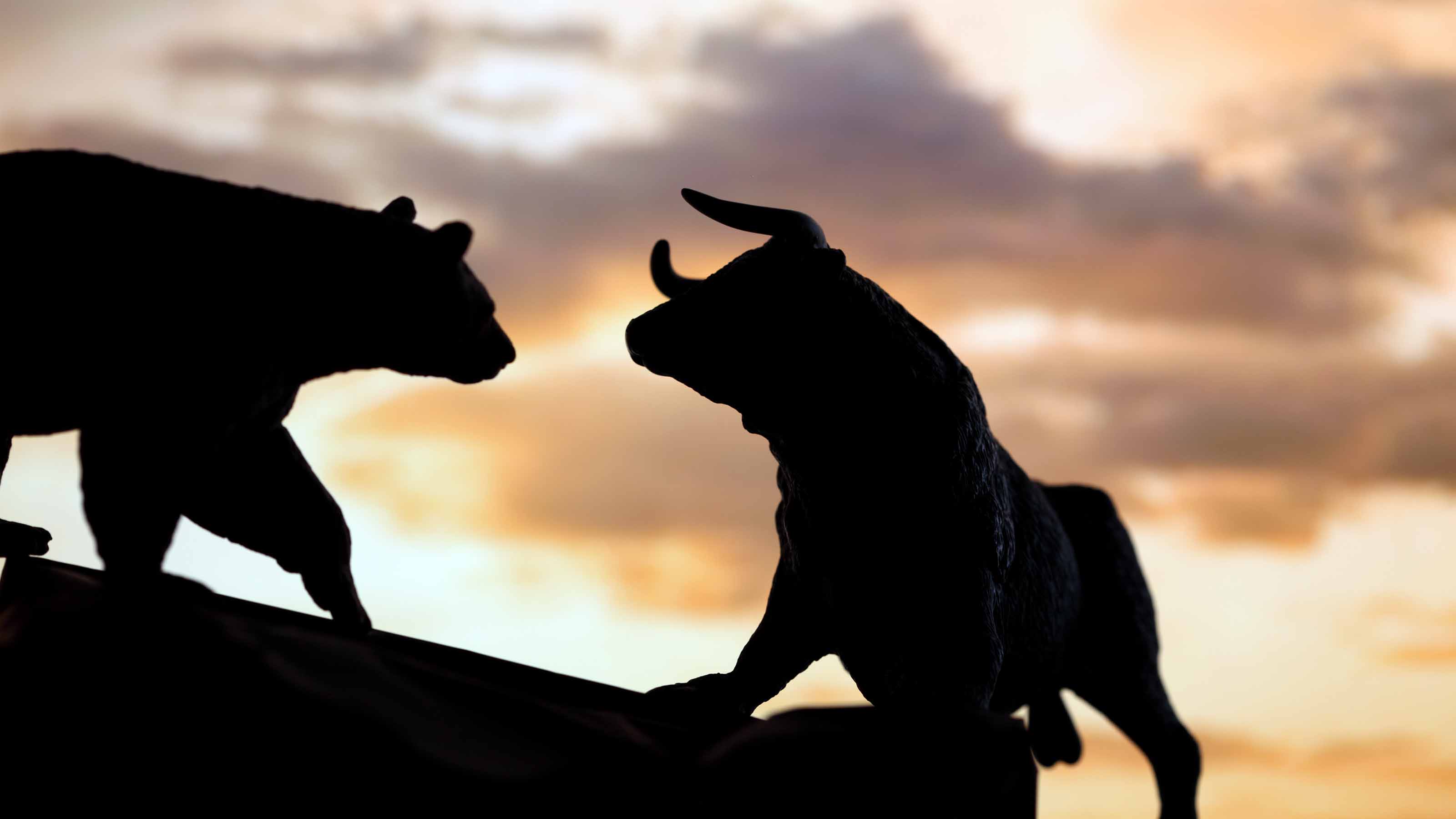Bull Markets vs Bear Markets: The Differences Explained
No one can predict when markets will rise or fall, so it's good to be aware of the characteristics of bull markets vs bear markets.


Investors with significant time in the market are probably familiar with bull markets vs bear markets. These technical terms describe the main parts of any typical long-term market cycle. But what are the characteristics and how can we plan for bull markets vs markets?
Bull markets show consistently rising stock prices over a period of time, usually at least six months. The longest bull market in history started just after the Great Recession in 2009 and ran through the beginning of the COVID-19 pandemic in 2020.
Bear markets are the opposite: Stocks slip and keep sliding. Lousy performance requires a shorter time frame before it's considered "bearish," though, even as limited a duration as one quarter. The longest bear market ever began with the burst of the dot-com bubble in 2000 and burdened investors until 2002.
From just $107.88 $24.99 for Kiplinger Personal Finance
Become a smarter, better informed investor. Subscribe from just $107.88 $24.99, plus get up to 4 Special Issues

Sign up for Kiplinger’s Free Newsletters
Profit and prosper with the best of expert advice on investing, taxes, retirement, personal finance and more - straight to your e-mail.
Profit and prosper with the best of expert advice - straight to your e-mail.
But why is a "bull" market considered a positive sign and a "bear" market a bad omen for investors? Maybe it's because bulls are known to charge wildly to get where they want. Bears can charge, too, but they tend to destroy things, eating, rummaging and generally causing more damage than bulls.
So, in that sense, markets can charge higher, wildly and with great power, just like a bull. But declining markets can seem like a bear ransacking a town — their destruction makes people lose confidence.
Let's take a closer look at some typical hallmarks and signs of bull markets vs bear markets, including investing strategies suited for each one.
What is a bull market?
"Once a bull market gets under way, and once you reach the point where everybody has made money no matter what system he or she followed, a crowd is attracted into the game that is responding not to interest rates and profits but simply to the fact that it seems a mistake to be out of stocks," said Berkshire Hathaway (BRK.B) CEO Warren Buffett.
At that point, according to Buffett, rising prices become a daily reinforcement and investors, conditioned like Pavlov's dogs, feel they can't miss the party.
It's not uncommon for analysts and observers to call a "bull market" when prices rise 20% or more from a previous low. However, there are many definitions of a bull market, with some saying one cannot be confirmed until the previous high has been taken out. Indeed, a bull market was declared in early January 2024, when the S&P 500 closed above its prior record set almost exactly two years before.
But by the time everyone agrees that point is reached, the bull market may not last too much longer. In fact, it often becomes more likely that the market becomes close to an inflection point when everyone recognizes a bull market. There can be a danger that if sentiment turns, everyone could rush for the exits and try to sell.
Ben Graham, the father of value investing, put it this way: "The longer the bull market lasts, the more severely investors will be affected with amnesia; after five years or so, many people no longer believe that bear markets are possible."
What strategies work best in a bull market?
It's impossible to know exactly when a bull market will start, but one way for investors to prepare for the next one is to keep buying high-quality stocks, even when they are falling.
By employing a dollar-cost averaging strategy of investing a fixed dollar amount over regular periods, investors can lower their average buy-in cost.
That way, when markets rebound, as they always do, the investor does not have to "time the market" or find an optimal point in which to jump in.
As for which investing strategies to employ, different sectors tend to outperform over various periods in a bull market. Early on, cyclical sectors like financial stocks and industrial stocks tend to outperform as they are most sensitive to interest rates and economic growth.
"Later, tech stocks tend to lead mid cycle, and commodity-linked sectors, including energy and materials, often outperform at the end stages of the economic cycle," write Anne Kates Smith, executive editor at Kiplinger Personal Finance Magazine, and Dan Burrows, senior investing writer at Kiplinger.com, in their feature "10 Things You Must Know About Bull Markets."
What is a bear market?
When looking at the differences between bear markets vs bull markets, a bear market is often defined as a decline of 20% from a previous high. It's not uncommon for this to happen during or right before recessions or periods of high unemployment.
Often, a bear market can occur in a very short period, even one to three months. The shortest bear market in history occurred at the onset of the pandemic in the spring of 2020, lasting just 33 days. The average length of a bear market since 1929, according to Ned Davis Research, is a little under 10 months. (The average length of a bull market, meanwhile, is roughly 2.7 years.)
"A bear market is one of the scariest events equity investors regularly confront," write Smith and Burrows in "How Often Bear Markets Occur and 7 Other Facts About Them." "And yet," they add, "as unpleasant as they may be, steep and sustained drawdowns in stocks are an absolute fact of investing life."
What strategies work best in a bear market?
Bear markets can certainly spark anxiety among investors as no one likes to experience losses. Some of the best strategies investors can employ to protect their portfolios during times of uncertainty are with defensive plays, like those found in utility stocks, consumer staples and healthcare stocks.
"Defensive stocks will lose ground in a bear market, but tend to lose less than average, supported by steady demand for their products and, often, generous dividends," write Smith and Burrows.
However, dollar-cost averaging works here too. Long-term investors see market dips as a unique opportunity to get high-quality stocks at inexpensive prices and can reduce their average cost basis by purchasing shares at lower prices.
After all, as Warren Buffett famously wrote in his 1986 shareholder letter, "Our goal is more modest: we simply attempt to be fearful when others are greedy and to be greedy only when others are fearful."
In other words, bear markets can lead to opportunities for long-term investors to put money to work. This is not unlike those folks who buy up real estate during slumps in the housing market.
This is one of the great benefits of a market downturn and one of the key differences between bear markets vs bull markets for attentive and astute investors. There's opportunity, if you know where to look and don't get scared off by a rampaging bear.
Related content
Profit and prosper with the best of Kiplinger's advice on investing, taxes, retirement, personal finance and much more. Delivered daily. Enter your email in the box and click Sign Me Up.

Mark R. Hake, CFA, is a Chartered Financial Analyst and entrepreneur. He has been writing on stocks for over six years and has also owned his own investment management and research firms focused on U.S. and international value stocks, for over 10 years. In addition, he worked on the buy side for investment firms, hedge funds, and investment divisions of insurance companies for the past 36 years. Lately, he is also working as Chief Strategy Officer for a tech start-up company, Foldstar Inc, based in Princeton, New Jersey.
-
 The Santa Claus Rally Officially Begins: Stock Market Today
The Santa Claus Rally Officially Begins: Stock Market TodayThe Santa Claus Rally is officially on as of Wednesday's closing bell, and initial returns are positive.
-
 How to Leave Different Amounts to Adult Children Without Causing a Rift
How to Leave Different Amounts to Adult Children Without Causing a RiftHere’s how to leave different amounts to adult children without causing a family rift.
-
 My Retirement Learning Curve, 1 Year In
My Retirement Learning Curve, 1 Year InA retiree checks in with what they wish they knew early on and what they've changed about their plan one year in.